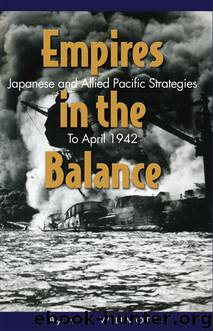Empires in the Balance: Japanese and Allied Pacific Strategies to April 1942 by Willmott H.P

Author:Willmott, H.P.
Language: eng
Format: epub
Publisher: Naval Institute Press
Published: 2014-07-14T16:00:00+00:00
Lieutenant General Hobum Yamashita, commander of the 25th Army. Regarded as perhaps Japan’s finest commander, the “Tiger of Malaya” ended the war on Luzon, where he conducted a rearguard action that did not end until Japan’s final surrender. Yamashita was executed after the war. Robert Hunt Library
Much of the reason for Yamashita’s confidence stemmed from his knowledge that the British mustered about 90,000 troops in Malaya, less than half of whom were Caucasians. The presence of so many Indian and Asian troops in Malaya prompted Yamashita to observe that the Japanese task would be made very much easier because of the high proportion of non-Whites in the defense. The Japanese had absolutely no regard for native troops; the idea of Asian troops offering effective resistance to the Japanese army was laughable to the Japanese. But Yamashita was aware not only of British weakness but also of the strengths and merits of his own forces, which had been brought to a high state of preparedness through the efforts of his chief of operations and planning, Colonel Masanobu Tsuji.
The colonel enjoyed an extremely unsavory reputation even in an army hardly noted for its exacting standards of personal behavior. He was a henchman of Tojo, and was despised for his role as Tojo’s stool pigeon, when the prime minister used him to report on the affairs and behavior of various generals. One of the reasons why Tsuji was on Yamashita’s staff was that Yamashita and Tojo loathed one another intensely. Tsuji’s unendearing traits combined extreme rudeness with irritability, but there was no disputing his industriousness, and equally there was no denying the fact that he achieved results. In January 1941 a new post was established for him as the second in command of the Taiwan Army Research Section, and head of the branch dealing with Malayan plans, at the jungle training school on Formosa. His task was to sort out all the problems of jungle warfare that the Japanese would have to face in Malaya. It was under the direction of this section that the main features of the strategy and tactics used in Malaya were devised. Under Tsuji’s direction Major Terundo Kunitake of the consulate in Singapore undertook a detailed reconnaissance of Malaya that revealed, among other things, that the Kroh-Grik track was passable and that no less than 250 bridges—more than twice the original estimate by the section—carried the road from Singora to Singapore.
The discovery of so many bridges was important to the Japanese because their campaign therefore had to become primarily an engineer’s operation. Kunitake’s information led to each of the three divisions earmarked for the campaign being given a complete sapper regiment with yet another regiment held under the direct control of army headquarters. These regiments were lavishly equipped by Japanese standards, their needs having been assessed by Tsuji and his section as a result of the study of Kunitake’s reports. Similarly, the infantry were given as much lightweight equipment as possible and trained intensively in the jungles and mountains of Formosa in flanking attacks through the jungle.
Download
This site does not store any files on its server. We only index and link to content provided by other sites. Please contact the content providers to delete copyright contents if any and email us, we'll remove relevant links or contents immediately.
The Vikings: Conquering England, France, and Ireland by Wernick Robert(79222)
Ali Pasha, Lion of Ioannina by Eugenia Russell & Eugenia Russell(39939)
The Vikings: Discoverers of a New World by Wernick Robert(36830)
The Conquerors (The Winning of America Series Book 3) by Eckert Allan W(36715)
Cecilia; Or, Memoirs of an Heiress — Volume 1 by Fanny Burney(32092)
Cecilia; Or, Memoirs of an Heiress — Volume 3 by Fanny Burney(31481)
Cecilia; Or, Memoirs of an Heiress — Volume 2 by Fanny Burney(31435)
Empire of the Sikhs by Patwant Singh(22779)
Hans Sturm: A Soldier's Odyssey on the Eastern Front by Gordon Williamson(18341)
The Secret History by Donna Tartt(18267)
Cat's cradle by Kurt Vonnegut(14804)
Sapiens: A Brief History of Humankind by Yuval Noah Harari(14006)
Pimp by Iceberg Slim(13828)
Talking to Strangers by Malcolm Gladwell(12916)
Norse Mythology by Gaiman Neil(12879)
Leonardo da Vinci by Walter Isaacson(12833)
Underground: A Human History of the Worlds Beneath Our Feet by Will Hunt(11857)
4 3 2 1: A Novel by Paul Auster(11842)
The Radium Girls by Kate Moore(11651)
